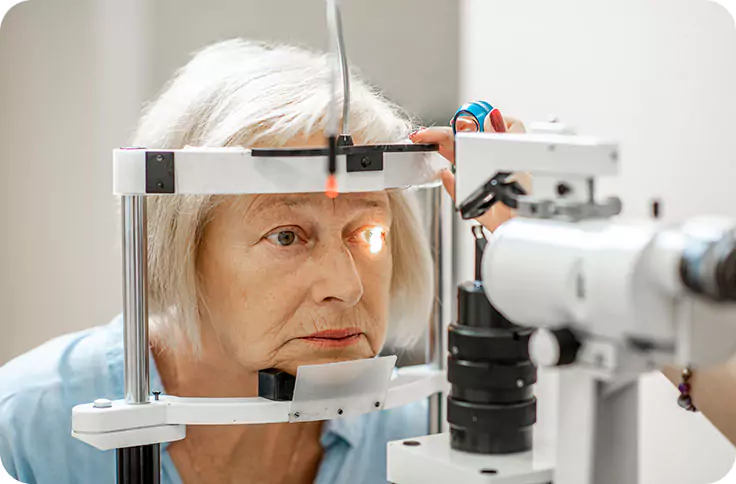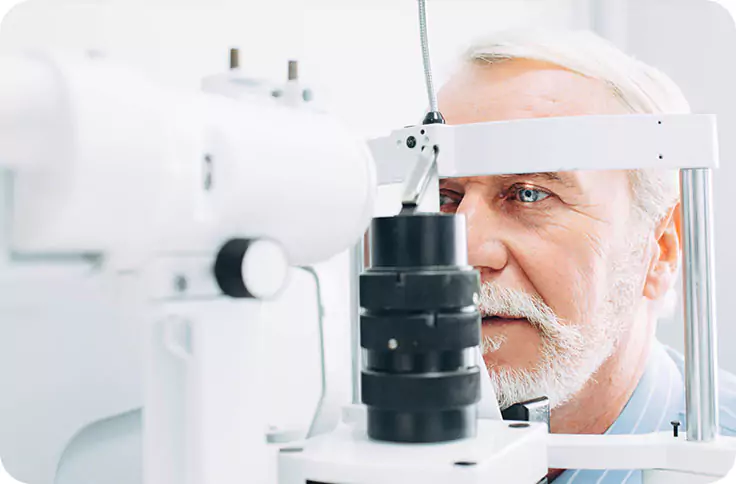Narrow Angle Closure Glaucoma: Can It Cause Blindness? Cure and Treatment
Is narrow-angle closure glaucoma dangerous? Learn about its symptoms, risk factors, treatment options, and whether it can lead to blindness.
Jan 8, 2023
Glaucoma
We'd love to tell you more
We won't bore you with the details, but Health Canada requires you to sign in.
By proceeding you agree to our Terms of Use & Privacy Policy
In this article
- What is narrow angle closure glaucoma?
- How serious is narrow angle closure glaucoma?
- What are the symptoms of narrow-angle-closure glaucoma?
- Can narrow angle closure glaucoma be cured?
- Can you go blind from acute angle-closure glaucoma?
- How do you treat closed-angle glaucoma?
- How fast does narrow-angle closure glaucoma happen?
Glaucoma is an eye condition that can damage the optic nerve in the eye. The optic nerve is responsible for capturing and sharing visual details with your brain. Glaucoma happens when there is increased pressure inside your eye (increased intraocular pressure), which damages the optic nerve. If left untreated, this may lead to loss of vision or blindness. However, with prompt diagnosis and treatment, you may be able to prevent vision loss and slow the progression of the disease.
Glaucoma can be classified into various types. The two most common types of glaucoma are:
- Open-angle glaucoma
- Acute angle-closure glaucoma (also known as narrow-angle closure glaucoma)
This article will discuss narrow-angle glaucoma, its symptoms, and treatment options. Also, you will find out what happens when it is not treated.
Let’s get started!
What is narrow angle closure glaucoma?
Angle-closure glaucoma is also known as narrow-angle glaucoma, caused by blockage of drainage canals in the eye. Blockage results in a sudden rise in eye pressure (intraocular pressure). Narrow-angle closure glaucoma is rare. It can develop quickly and requires immediate medical treatment.
How serious is narrow angle closure glaucoma?
An acute episode of narrow-angle glaucoma is considered a medical emergency. If the pressure in the eye is not decreased quickly, there is a possibility that you may have permanent vision loss. If you have severe pain in one eye, headache, halos around lights, or blurry vision that comes on suddenly, go to the nearest emergency department.
What are the symptoms of narrow-angle-closure glaucoma?
Narrow-angle closure glaucoma is referred to as a sneaky thief of sight. Often, people affected by the disease do not experience any warning symptoms. The pressure in the eye increases drastically and within a short period. When an acute episode occurs, symptoms include:
- Headache (moderate to severe)
- Eye pain (usually in one eye only)
- Blurred vision
- Nausea
- Red eyes
- Halos around the lights
- Mid-dilated pupil
- Sudden loss of sight
If you experience any of these symptoms, you should immediately go to the nearest emergency room.
Can narrow angle closure glaucoma be cured?
Eye surgery (a procedure called laser peripheral iridotomy) can be done to keep the drainage in the eye unblocked permanently. For some people, this surgery keeps intraocular pressure at a healthy level, and no other treatment is required. For others, eye pressure may still be elevated after surgery, which requires ongoing medications for treatment.
Can you go blind from acute angle-closure glaucoma?
Acute angle closure glaucoma is a serious medical emergency. If the intraocular pressure is not decreased by treatment, it may cause blindness. Hence, if you experience any symptoms related to acute angle closure glaucoma, immediately seek medical attention.
How do you treat closed-angle glaucoma?
If you experience symptoms of narrow-angle glaucoma, visit an eye doctor or emergency room immediately. Treatment must begin as soon as possible to minimize the risk of permanent blindness. Once a diagnosis of narrow-angle glaucoma is confirmed, the first step of treatment is applying eye drops to reduce the pressure in your eyes.
After the eye pressure is reduced, your doctor may perform a procedure called laser iridotomy. In this procedure, laser light is used to create a small hole in the iris (the coloured part of your eye). This allows fluid in your eye to drain easily to prevent future episodes of narrow-angle glaucoma.
What drugs treat closed-angle glaucoma?
Your eye doctor may recommend medications that:
- Decrease the amount of fluid that your eyes produce
- Unblock the drainage by narrowing your pupil
- Encourages fluid in the eye to shift into the bloodstream
Medications may be eye drops, pills, or IV medicines.
Various medications include:
- Acetazolamide (decreases the fluid in your eye)
- Painkillers (to provide comfort)
- Beta-blockers (lowers the amount of fluid your eye produces)
- Medications for nausea and vomiting
- Pilocarpine (opens the angle between your cornea and iris)
- IV mannitol to draw fluid from the eye into the bloodstream
How fast does narrow-angle closure glaucoma happen?
Glaucoma is typically a slow, progressive disease. However, in the case of narrow-angle closure glaucoma, eye pressure rapidly increases due to a complete blockage of drainage. Symptoms like severe eye pain, headache, halos, and blurry vision flare up suddenly. Angle-closure glaucoma is a medical emergency, and you should get medical attention as quickly as possible. If not treated, this glaucoma may cause blindness in the affected eye within 3-5 days.
Join Pocketpills.
Get care that fits your life. See a doctor, order prescriptions, and manage your health from home, on your schedule.
Get StartedSimilar Articles

Narrow Angle Closure Glaucoma: Can It Cause Blindness? Cure and Treatment
Glaucoma is an eye condition that can damage the optic nerve in the eye. The optic nerve is responsible for capturing the visual details and sharing them with your brain. Glaucoma happens when there is increased pressure inside your eye (increased intraocular pressure) which damages the optic nerve. If left untreated, this may lead to loss of vision or blindness. However, with prompt diagnosis and treatment, you may be able to prevent vision loss and slow the progression of disease.
Jan 8, 2023

Open Angle Glaucoma: Treatment, Signs and Symptoms, Medications, Blindness And More
Glaucoma is an eye disease that can damage the optic nerve in the eye. The optic nerve is responsible for capturing the visual details and sharing them with your brain. Glaucoma causes increased pressure inside your eye (increased intraocular pressure), which in turn damages the optic nerve. If untreated, this may lead to loss of vision or blindness. However, if you start treatment early, you may be able to prevent vision loss and slow the progression of the disease.
Jan 8, 2023
